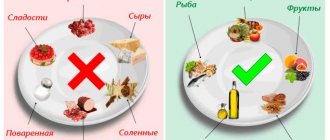Diet for gestational diabetes in pregnant women is the first method of treating this disease. This is what specialists resort to if a pregnant woman is admitted with a diagnosis of GDM. Insulin is a last resort method, which is used only if a woman is unable to follow the diet or does not have a significant effect.
It is important to remember that failure to follow a diet with this diagnosis leads to a number of complications. It is easier to remove or replace sugar in your diet than to try to cope with the serious consequences of GDM. That is why, if diet therapy has been prescribed, it must be carefully followed.
The diet for GDM is no different from that of diabetics. In both gestational diabetes and classic forms of the disease, the main goal is to normalize blood sugar levels.
Why is a diet prescribed?
What can you eat if you have GDM?
The main thing that every pregnant woman who has been diagnosed with this should know is proper nutrition. Despite the seriousness of the disease, it does not mean that you need to completely remove foods containing sugar from your diet. The main thing is that there is an acceptable amount of it. Permitted and prohibited products can be viewed in the following table.
| type of product | Allowed | Prohibited |
| Bakery and flour products | Rye and bran bread, second-grade wheat bread, non-butter products. | Any products made from puff pastry and butter dough. |
| Poultry and meat | Lamb, pork, beef (meat should be lean), rabbit, chicken, turkey. Dietary sausage and frankfurters. | Goose or duck, canned food, any sausages. |
| Seafood | Any low-fat fish. Cod liver in strictly limited quantities. | Fatty fish, canned food, black and red caviar. |
| Dairy | Milk, fermented milk products, low-fat cheese, cottage cheese. Sour cream should be taken with low fat content and its quantity should be limited. | Salty and fatty cheese, sweet dairy products, cream. |
| Eggs | Up to two eggs a day. | Limit the consumption of yolks. |
| Vegetables | Potatoes, carrots, beets and green peas with counting of bread units. Cabbage, zucchini, tomatoes, cucumbers, eggplants, pumpkin. | Any pickled and salted vegetables, such as sauerkraut or pickles. |
| Fruits and berries | Oranges, tangerines, mangoes, apples, grapefruit, pomegranate, kiwi. In general, almost all fresh fruits are sweet and sour. | Grapes, bananas, dates, figs, persimmons, pineapple. Grape leaves can be used in cooking. |
| Beverages | Tea and coffee, chicory, freshly squeezed vegetable juices, dried fruit compote without added sugar, rose hip decoction. | Alcohol, sweet juices, carbonated drinks, lemonades with added sugar. |
| Cereals | Buckwheat, millet, oatmeal, pearl barley. | Semolina, corn, any pasta (must be limited). Rice. |
| Legumes | Chickpeas, lentils, peas, beans. Any legumes should be consumed in limited quantities. |
The list of permitted products is quite wide. It is necessary to exclude excessively fatty foods such as seeds or nuts from the diet. Peanut butter should also not be consumed. Dark chocolate can be eaten in strictly limited quantities. You can't eat ice cream as a sweet treat. It is better to exclude all sweets, replacing them with fresh fruits and berries.
Menu Basics
If a pregnant woman is diagnosed with gestational diabetes during a glucose tolerance test, her doctor will begin treatment for her.
After making a diagnosis, the specialist will determine which foods you can eat and which you should avoid.
If a disease is detected, patients must completely stop using:
- all sweet products (this applies to both sugar and honey, ice cream, sweet drinks and the like);
- white bread, pastries and any flour products (including pasta);
- semolina;
- semi-finished products;
- smoked meats;
- fast food products;
- fast food;
- fruits containing a lot of calories;
- lemonades, juices in packages;
- fatty meat, jellied meat, lard;
- canned food, regardless of their type;
- alcohol;
- cocoa;
- cereals, diet bread;
- all legumes;
- sweet yoghurts.
You will also have to significantly limit your use of:
- potatoes;
- butter;
- chicken eggs;
- baked goods from uneatable dough.
Products from the list of prohibited foods should be completely excluded from the diet. Even their small consumption can lead to negative consequences. Potatoes, butter, eggs and baked goods are allowed to be consumed in very limited quantities.
What can pregnant women eat with gestational diabetes? The above products can be replaced:
- hard cheeses;
- fermented milk cottage cheese;
- natural yoghurts;
- heavy cream;
- seafood;
- green vegetables (carrots, pumpkin, beets, unlike cucumbers, onions and cabbage, must be consumed in limited quantities);
- mushrooms;
- soybeans and products made from it (in small quantities);
- Brazil nuts;
- tomato juice;
- tea.
This is due to the fact that if there is insufficient carbohydrate intake from food, the body will begin to burn fat reserves for energy.
In most cases, doctors prescribe to their patients a diet containing more carbohydrates and moderate amounts of protein. Preference is given to unsaturated fats, the consumption of which, however, must also be limited. Saturated fats are completely excluded from the diet.
Diet 9 can be used. However, it is contraindicated in acidosis. And since some pregnant women have a similar problem due to severe toxicosis, it is necessary to make sure that it is possible to follow such a diet. There are several sample menu options for pregnant women with gestational diabetes. They are shown in the following table:
All diet options provided in this table are allowed for gestational diabetes. The woman herself must decide which option to choose, focusing on her taste and the availability of products included in a particular diet.
What not to eat if you have GDM
The table above describes most of the foods that should not be consumed. One of the important points is the ban on drinking alcoholic beverages that harm the fetus, even if the mother does not suffer from GDM. In this case, alcohol also worsens the course of the underlying disease.
Carefully! Even taking minimal doses of alcohol with gestational diabetes mellitus can significantly increase the disturbance of carbohydrate metabolism in the body. Sweets also need to be excluded completely. Chocolate, candy, ice cream and other sweets significantly increase blood sugar levels. If you really want something sweet, you can eat special candies and cookies for diabetics. They contain safe carbohydrates.
Why is uncontrolled eating dangerous?
Nutrition for gestational diabetes should be balanced. Uncontrolled consumption of food will affect the health of the woman and her child. In addition, this can cause an abnormal course of pregnancy and labor. Here are the consequences that should be expected when pregnant women with diabetes eat a diet that does not meet the norms:
- The maturity of the placenta comes prematurely, so the baby, who has not yet been born, will suffer from a lack of oxygen and nutrients.
- Circulatory problems may occur between the fetus and the woman.
- The formation of blood clots that can break off unexpectedly can lead to thrombosis.
- The fetus can develop very large, which will lead to complications during delivery.
- The baby may be delayed in its development and not match the mother's gestational age.
That is why you should pay close attention to the diet for gestational diabetes in pregnant women. It will help you bear a healthy baby and get through your pregnancy calmly.
It should be remembered that the diet is not aimed at infringing on a woman’s nutritional interests, but at caring for her health and the health of her unborn child.
What foods should you limit in your diet?
You can eat some foods with gestational diabetes, but you need to limit their consumption and carefully count bread units.
Such products include the following.
- Bakery products and pasta. Despite the fact that many of them are allowed for GDM, some authors recommend strictly limiting these products. Particular attention should be paid to dumplings, pancakes, and pies. It is better not to eat them at all, and replace classic pasta with egg noodles.
- Vegetables. You should limit your intake of potatoes and beets, as they are rich in starch, as well as carrots.
- Fruits. It is better to limit sweet fruits to one consumption per week. You should also avoid frequent consumption of avocados and prunes.
- Beverages. Cocoa and drinks containing coconut milk should be limited, or better not consumed, especially if there is a significant increase in blood sugar. Coffee and tea are allowed, but they must be drunk without sugar or use a sweetener.
Sushi and rolls, which have become quite popular recently, contain avocado, rice, and fatty fish. Therefore, despite the “lightness” of this dish, if GDM is diagnosed, it is better to completely abandon it or consume it extremely rarely and in small quantities.
There is no need to think that the products on this list cannot be eaten either. There are many types of diets, the choice of which depends on the individual condition of the patient. When drawing up a sample menu, the doctor will take into account not only the diagnosis, but also the severity of the condition.
Postulates of proper nutrition
The organization of nutrition for diabetes mellitus that arose during the perinatal period is built according to the rules that a pregnant woman must follow:
How to measure sugar?
- Eliminate monosaccharides and disaccharides from the diet. These are simple carbohydrates that are quickly processed by the body, forming glucose, which is instantly absorbed into the systemic bloodstream. Fast carbohydrates are found in sweet foods and ready-made meals and drinks.
- Introduce fiber-rich foods into your diet. Complex carbohydrates (polysaccharides) are absorbed and digested gradually. Their consumption does not cause a significant increase in blood sugar, improves digestive processes, and enriches the body with minerals and vitamins. This category includes vegetables, legumes and cereals.
- Replace 50% of animal fats with vegetable oils. Animal fat accelerates the resorption (absorption) of glucose from other foods into the blood. In addition, it promotes the accumulation of low-density lipoproteins (“bad” cholesterol) on the walls of blood vessels. The daily intake of unsaturated (animal) fats should not exceed 10 g. Vegetable fats do not contain cholesterol, but they contain essential polyunsaturated acids Omega-3 and Omega-6, which are not synthesized by the body, but are extremely necessary for it. You should not get carried away with oils because of the high energy value of the products (more than 800 kcal per 100 g).
- Increase the amount of protein in your diet. When consuming proteins, the body receives essential amino acids (20 in total), which it cannot produce on its own. The process of formation of glucose molecules from these amino acids (gluconeogenesis) occurs slowly and has a negligible effect on sugar levels.
You should not overuse protein foods. Excessive amounts of protein can cause excess uric acid. It is necessary to set a strict limit on the consumption of table salt. This will help relieve the renal apparatus and avoid swelling. Monitor the energy value of foods. This measure will prevent you from gaining extra pounds. It is recommended not to go beyond the daily norm of 35–40 kcal per kilogram of weight. Don't be greedy when eating. Pregnant women, as a rule, have an increased appetite, gestational diabetes, which further increases the feeling of hunger. The situation must be strictly controlled.
Overeating, even acceptable foods, provokes instability of glycemia (sugar levels). A single serving should not exceed 350–400 grams. Maintain drinking regime. The body should not experience a lack of fluid. The optimal dose, with stable kidney function, is 1.5–2 liters per day. Adhere to a rational diet by the hour. The interval between meals should be 3 hours. When treating diabetes mellitus, it is strictly forbidden to fast. Ideal scheme: breakfast - lunch (snack) - lunch - afternoon snack - dinner - evening kefir or other fermented milk drink.
Eliminate dishes prepared by the culinary method of frying from the menu. Frying foods increases the calorie content of the dish, which leads to weight gain. When preparing, preference should be given to stewing, boiling, and steaming. Monitor the glycemic index (GI) of foods and ready-made meals. GI is a value indicating the rate of food processing, glucose release and resorption into the blood.
The higher the GI, the faster the listed processes occur in the body. When developing a menu, you need to check the glycemic index table for each product. Food indexed with digital values of 70 or higher is excluded from the diet. Average GI (from 30 to 70) means that foods are subject to consumption restrictions. Foods with an index of 30 and below are safe for diabetics.
During the frying process, harmful carcinogens are formed, which increase the load on the weakened pancreas and are harmful to the fetus.
When compiling a diet, it is recommended to rely on dietary “Table No. 9”. If a woman is diagnosed with acidosis in parallel with gestational diabetes, i.e. a shift in the acid-base balance (decreased pH), it is necessary to adjust the menu with a doctor, since some products of the ninth diet are contraindicated for this disease.
In addition to diet, clinical recommendations for GDM include:
- Permanent monitoring of sugar levels (up to 4 times a day), recording them in a special diary (all foods and dishes that a woman eats during the day are also recorded there). This will help the doctor analyze the dynamics of the disease and the dependence of digital glucose values on the foods eaten.
- Refusal to take dietary supplements for weight correction and sweeteners. In the first case, because dietary supplements negatively affect metabolic processes. In the second, food additives E950 (acesulfame potassium), E951 (aspartame), E952 (sodium cyclamate) are excluded. Their teratogenic effect has not been fully studied, so you should not put your unborn baby at risk. Xylitol and sorbitol are also not recommended due to their high energy value.
- Systematic physical activity. Treatment of gestational diabetes includes mandatory physical activity appropriate to the woman’s condition. Exercising saturates cells and tissues with oxygen, increases glucose tolerance, prepares the body for childbirth, and promotes weight loss.
Important! Physical exercises should not be performed to the limit. The load should be agreed upon with the gynecologist leading the pregnancy.
Food diary for GDM
This is a great way for the expectant mother to closely monitor the disease. Experts often recommend keeping two diaries. One will contain glucometer data. This is necessary so that the doctor can evaluate your sugar levels in detail at different times. In total, you need to measure it 7 times a day. No special diaries are required. A regular notebook will do.
There is no sample as such; it is better to create a table yourself into which the data will be entered. The main thing is that it includes all seven measurements (before and after each main meal, as well as before bed).
A food diary is a detailed description of what the pregnant woman ate. Moreover, it is important to know how many calories were eaten, as well as how much protein, fat and carbohydrates each dish contained. As a result, the data obtained from both diaries allows the doctor to assess the correctness of diet therapy, as well as its effectiveness.
Table 9 for gestational diabetes mellitus in pregnant women
Dietary tables according to Pevzner have been used in the treatment of many diseases for quite a long time. For diseases associated with increased blood sugar levels, including GDM, it is recommended to use table No. 9. It is suitable for those who do not receive insulin or receive it in small doses.
The main goal of this diet is to normalize carbohydrate metabolism in the body and reduce the risk of fat metabolism disorders. The basic principle of the diet is the predominance of animal fats and easily digestible carbohydrates in the diet. Avoid eating sweets and sugar completely. Reduces salt and cholesterol intake. It is preferable to cook by boiling or baking. Sweeteners may be used.
The essence of the phenomenon, causes of development and diagnosis
Translated from Latin, the word “gestation” means pregnancy. Accordingly, GDM is a disease that manifests itself in pregnant women. The essence of the problem is an increase in glucose levels in the bloodstream. A similar phenomenon can be observed both during a normal meal and after eating a large amount of foods containing glucose.
The disease usually does not cause any symptoms. That is, in most cases it is impossible to detect it on your own (there is not a single symptom that would allow you to do this). The problem is diagnosed during examinations and special tests.
Statistics show that approximately fourteen percent of pregnant women are susceptible to developing this type of diabetes. Moreover, ten percent of the fairer sex who suffered from the disease during pregnancy develop the second type of diabetes mellitus within ten years after childbirth.
The reason for the development of gestational diabetes lies in the hormonal changes that occur in a woman’s body from the beginning of pregnancy.
After conceiving a child, the pregnant woman’s body begins to intensively release insulin, a hormone important for the absorption of glucose. During a normal pregnancy, the level of this substance in the bloodstream should increase three times compared to normal levels.
The pancreas is responsible for producing insulin. In some women, it cannot cope with the load, which is why an insufficient amount of this substance is produced. As a result, the longer pregnancy continues, the higher the concentration of glucose in the bloodstream becomes. However, the pancreas cannot produce enough insulin for its normal metabolism. This leads to the gradual development of gestational diabetes.
Women are more susceptible to developing this disease:
- at the age of thirty;
- who have previously given birth to a child weighing more than four kilograms;
- having problems with excess weight;
- having poor heredity (the presence in the family of persons who suffered from this disease).
To detect the disease, a two-hour oral glucose tolerance test is performed. Typically, the detection of gestational diabetes at a late stage is associated with a lack of proper preparation for the test, which must begin not in one day, but three days in advance. Often pregnant women eat before the test, which distorts the result and makes it impossible to make a correct diagnosis.
In most cases, the disease is diagnosed twenty-eight weeks after the start of pregnancy. If treatment is not started on time, the fetus may develop heart and brain defects, which will significantly affect its entire future life. In addition, cesarean section is prescribed for gestational diabetes. This procedure is carried out because during natural childbirth the child and mother can suffer serious injuries.
When GDM is detected in a pregnant woman, the main task facing the attending physician is to normalize and maintain optimal blood sugar levels in the patient. Since there are restrictions on taking medications during pregnancy, proper nutrition is the basis of treatment.
Menu for every day
This low-calorie diet, despite significant restrictions on the consumption of certain foods, can be quite varied. For breakfast, you can eat low-fat cottage cheese with milk or porridge, preferably buckwheat. You can also have tea for breakfast, but don’t add sugar.
For lunch, it is preferable to cook soups. Examples include vegetarian cabbage soup and boiled meat. You can also prepare a vegetable salad. A little later you should eat a green apple. For dinner, bake boiled fish in milk sauce, and drink a glass of kefir before going to bed. It’s possible to create a varied menu for a week that will satisfy the hunger of any gourmet.
There are a lot of delicious recipes
Menu for the week
An approximate weekly diet for diabetes can be quite varied and depend on the individual preferences of the pregnant woman.
| Day | Breakfast | Dinner | Dinner |
| Monday | Oatmeal with water. Low-fat cottage cheese. | Salad of tomatoes and cucumbers. Cabbage soup made from fresh vegetables. Steamed cutlets. | Boiled beef with buckwheat. |
| Tuesday | Omelet from a couple of eggs. Cheese cheese with rye bread. | Borscht with lean broth. Veal with vegetables. | Lentil cutlets with a side dish of fresh vegetables. |
| Wednesday | Pearl barley porridge. Cottage cheese. | Greek salad. Stuffed peppers. | Low-fat fish with a side dish of vegetables. |
| Thursday | Millet porridge. Low-fat cheeses. | Chicken soup with durum noodles. | Turkey with broccoli or cauliflower. |
| Friday | Cheesecakes with a little sour cream. | Eggplant with garlic. Buckwheat porridge with meat. | Fresh vegetable vinaigrette. Chicken cutlets. |
| Saturday | Soft-boiled egg. Baked potato. | Vegetable stew with meat. Cabbage and tomato salad. | Boiled beef in milk sauce. |
| Sunday | Cabbage cutlets. Rye bread. | Buckwheat with steamed cutlets. | A small amount of rice with any meat. |
For drinks, you can drink coffee or tea without sugar. If it is difficult to drink unsweetened, you can use approved sweeteners. For second breakfasts and afternoon snacks, you can eat fresh fruits and permitted berries.
Menu options
The menu for gestational diabetes must be thought out in advance, taking into account all the important nuances.
Option 1. It is recommended that a pregnant woman have breakfast with buckwheat, which is boiled in water. The permissible amount is no more than 180 g. You can drink it with regular tea, but not strong. After a couple of hours, you can snack on 1 orange, a slice of rye bread with 2 slices of cheese (but only low-fat).
For lunch, you need to eat buckwheat soup, which is cooked in meat or vegetable broth. Only 100 ml required. For the 2nd course - 50 g of stewed or boiled veal and the same amount of boiled beets, grated. It is allowed to add a small amount of oil. 2 pieces of gray bread are allowed. After a couple of hours, you are allowed to continue eating a couple of crackers and 80 g of low-fat cottage cheese.
For dinner you can eat 120 g of mashed potatoes, 80 g of green peas and a piece of whole grain bread. Wash everything down with a cup of rosehip decoction. Before going to bed, you are allowed to have a snack with a sandwich of gray bread and cheese. You can eat 100 g of low-fat sour cream.
Option 2. If gestational diabetes is detected, then wheat porridge cooked in water is allowed for breakfast. You can drink it with regular black tea without sugar. After a couple of hours - a piece of cottage cheese casserole.
Lunch includes:
- beet soup;
- chicken fillet;
- a slice of black bread.
Any fruit is suitable as an afternoon snack, but only from the list of permitted ones. If a woman has gestational diabetes, then buckwheat porridge, baked pink salmon and a tomato and cucumber salad are allowed for dinner. Toasts are allowed. Before going to bed, drink green tea.
Option 3. For pregnant women with diabetes, oatmeal is recommended for breakfast, to which you can add dried fruits. Additionally, you can drink tea with a bread and butter sandwich. After a couple of hours, you are allowed to snack on cottage cheese and an apple.
At lunch, the food will be as follows: turkey-based broth, wheat porridge and steamed fish cutlets. 2 slices of bread are allowed. After a couple of hours, you can have a snack with any vegetable salad.
Dinner was supposed to be stewed cabbage. It is recommended to boil fish with it. Wash everything down with herbal decoction. Before going to bed, we recommend a piece of black bread and a little natural yogurt, without additives.
Option 4. If gestational diabetes mellitus appears, then for breakfast you can eat a couple of boiled eggs with toast (use only rye bread to prepare them). Wash everything down with tea. After 1-2 hours, you can snack on toast with cheese and wash it down with weak coffee.
Lunch includes lentil soup. For the 2nd course - buckwheat porridge with stewed beef. A small slice of bread is allowed. Wash everything down with tea. After a couple of hours, you can have a snack with cottage cheese and any permitted fruit.
If you have gestational diabetes, you can cook vegetable stew and boil chicken fillet for dinner. 1 piece of bread is allowed. Wash everything down with mint tea. Before going to bed, you are allowed to drink a glass of fermented baked milk.
Arbatskaya diet for GDM
Observation Endocrinologist Arbatskaya has developed her own diet, which she recommends for women suffering from GDM. In this case, the basis of proper nutrition should be considered the glycemic index (GI) - the rate at which carbohydrates are absorbed. The higher this index, the faster your blood sugar rises. Therefore, it is necessary to exclude foods that have a high glycemic index from your daily diet.
So, it is necessary to exclude the following foods from the diet.
- GI - 90-100%. Honey, soda, corn flakes, mashed potatoes.
- GI - 70-90%. Bakery products, dates, grapes, alcohol, risk, biscuits, yoghurts.
- GI - 50-70%. Bananas, rye bread, natural low-fat yogurt, most sweet fruits.
Everything that has a glycemic index below 50% should prevail in the diet of a pregnant woman.
Diet table 9
This is not an ordinary diet, but with a therapeutic bias, designed specifically for diabetics.
You should not adhere to this diet on your own, but only with a doctor’s prescription. The basic principles of diet No. 9 are very similar to the nutritional principles described above. Its key point is to reduce the amount of consumption of easily digestible carbohydrates and the total calorie content of dishes.
You can choose a list of healthy and not so healthy foods based on the glycemic index table (the rate of breakdown of carbohydrates). The lower the indicator, the healthier the product.
Followers of the diet are advised to completely eliminate canned food, mustard and alcohol, and give up sugar in favor of a sweetener.
Diabetics need to fill their diet with all the necessary nutrients, eat foods with ascorbic acid and B vitamins (rose hips, bran). Be sure to include greens, fresh berries, fruits and vegetables, cottage cheese, oatmeal, lean fish, and cheese in the menu. It is better to use olive oil as a salad dressing.
Interesting article: Diet and diet for pregnant women: everything you didn’t know!
Low carb diet
According to studies, it shows the best results in the treatment of GDM. Also, as in the case of the Arbatskaya diet, nutrition should be based on the predominance of foods with a low glycemic index in the diet.
An approximate menu for one day, with a diet of this type, may look like this.
- Breakfast. 250 g of porridge (it is necessary to exclude semolina and rice). A few pieces of cheese with rye bread. Black tea (do not add sugar).
- Lunch. Apple.
- Vegetable salad 100 g. Borscht. Steamed cutlets.
- Afternoon snack. 100 g cottage cheese. Rosehip tea or decoction.
- Dinner. Stewed cabbage with boiled meat.
Expert opinion Olga Borovikova In general, a low-carbohydrate diet can be quite varied, especially if you carefully study the foods that can be eaten. To create a more detailed menu, it is better to seek help from a nutritionist or endocrinologist.
New Year's table at GSD
This holiday causes an exacerbation of many diseases. Including diabetes. For our people, this holiday is considered sacred, and the diet on this day is never followed by anyone. It is important to make not only a delicious New Year's table, but also one that does not harm the pregnant woman.
It’s hard to imagine the New Year without tangerines. This fruit is allowed for consumption, but you cannot eat too much of it; only 3-4 fruits are allowed in one day. However, one classic element of the New Year's table can be left.
Also, the following dishes can be used on the festive table:
- olives;
- carved turkey (roasted);
- fresh vegetable lasagna;
- dietary sausages and cheeses;
- salads (Greek, Jerusalem artichoke, seafood, etc.);
- allowed desserts.
In general, the New Year's menu can be quite extensive. The main thing to remember is to exclude alcohol. A pregnant woman with GDM is prohibited from even a glass of champagne. It is better to replace it with healthier drinks.
You can't even have champagne
GDM and what it is eaten with - my current diet experience
Good day to all!
During my second pregnancy, I encountered gestational diabetes during pregnancy immediately upon registration at 7-8 weeks. I looked for information, talked with doctors, other girls from the State Duma and forums, and collected some information for myself. There will be a lot of text, I’ll publish it in case someone finds it useful.
Important!
Girls, this is my experience, and I share it in some detail. Remember that GDM is an individual thing, your experience or reactions to foods may be different!
So, the background (if you are not interested, you can scroll to the essence of the diet  ) :
) :
During my first pregnancy I didn’t have any problems with sugar, I didn’t have any family history, and I was underweight. The pregnancy with my first baby was interrupted long term. The endocrinologist believes this contributed to GSD in the second pregnancy. In her opinion, a burdened gynecological history (miscarriages, frozen eggs, etc.) and a state of frequent or severe stress are a direct path to diabetes, regardless of weight, nutrition or family predisposition. Take care of yourself!
During my second pregnancy, with a height of 172, I weighed 52 kg; in the first 2 months of the diet, the weight dropped to 49. Surprisingly, the weight did not go further down and began to grow bit by bit. The doctor considers this to be the absolute norm. I’ll add that by 37 weeks the weight gain was 7 kg. Sugar at registration was 5.2. According to the latest standards in the Russian Federation for pregnant women on an empty stomach from a vein of 5.0 and above - GSD. In my case, they slapped the diagnosis right away and didn’t let me retake it. They said there was no point, if he came out once, that means the State Duma. In general, I'm glad about this, because... through observation, sugar actually rises higher than my husband’s))
What are the dangers of GDM? First of all, it is dangerous for the baby. These are developmental defects, this is swelling of organs and tissues, this is a lot of weight with prematurity, this is a lot of weight and the need for delivery when the baby’s organs are still immature, fetopathy, the risk of hypoglycemia in the child after birth, because his pancreas from some point in the womb begins to work to help yours, although such a load is premature for her. I read about cases of diabetes in children after their mother’s GSD. It is in our interests to protect our babies and help our bodies cope with this disease. And the diet is quite balanced, proper nutrition is good for us.
The essence of the diet:
eliminate fast carbohydrates and replace them with slow ones that take as long as possible to absorb and digest. It is recommended to eat everything as dietary as possible - boiled/boiled/steamed/baked meat, vegetables, fresh salads, all types of cabbage, legumes, sour fruits, citrus fruits, berries (currants, cranberries), fermented milk without additives, eggs, cottage cheese, dark whole grain pasta, rye, whole grain or table bread (without premium wheat flour in the composition!).
In this diet, it is important to eat undercooked, slightly hard foods, so that the body takes longer to process and digest what you eat. For example, an apple or an apple lozenge without sugar are completely different things. You eat the green apple for a few minutes, then until it is digested and the sugar is gradually released from it. The lozenge has already been processed - and now you also ate an apple in 10 seconds and the natural sugar from this processed apple immediately soared in your blood. The same applies to juices and baby purees - exclude them. You won’t catch this race, but it will happen.
With GSD, the following are completely excluded: everything sugary, sweet, buttery, cookies, waffles, candies, marshmallows, cakes, gingerbread, etc., rolls, bread with wheat flour, jams, honey, baby purees and marshmallows (even if “without sugar” " on the label), exclude dietary sweets, only stevia, persimmon, bananas, grapes, juices (only tomato without sugar is allowed, if there is no individual reaction), fatty meat, fatty fish, fried poultry, processed cheese, fatty cheeses, curd cheeses, yoghurts with additives, white rice, semolina, millet, wheat, corn, corn flour, mashed potatoes, quick cereals (3-5 minutes of cooking), regular pasta, semi-finished sausages, canned food, pickles with sugar, sauces and store-bought mayonnaise are excluded.
It is recommended to limit potatoes, but I know girls who do well with 2 boiled potatoes or a whole large tuber baked in foil with skin. It is also recommended to limit beets, but borscht worked for me, but boiled beets with garlic did not. I tried baking vegetables in the oven in foil a la vinaigrette - beets, carrots, potatoes, then added onions, fresh cucumber and dill + a drop of olive oil - it went well. The difference in cooking or almost-ready baking vegetables in foil turned out to be very obvious to me.
Many people’s bread doesn’t come through at all, measure it! The same goes for bread. I had no more than 2 pieces of canteen and rye all day. Or I bake it at home - 1 cup of kefir, salt, soda and rye flour + a little oatmeal, knead into a bun or baguette shape, as you like, and into the oven until ready. I can eat more of it, there is no sugar and yeast, it goes better. Homemade lavash (salt, water, whole grain flour) roll out flatbread thinly and in a dry frying pan on both sides, wrap for a while in a wet towel then for softness) is also a thing, you can wrap anything in it - cheese and herbs and bake, or similar shawarma - salad + boiled breast inside))). Yes, even wrap the breast with cheese, put several pieces of pita bread in a snail shape and pour in an egg with sour cream or omelette and bake, cut like a regular pie, if it’s round, then into triangle sectors - in general, a quite satisfying pie! With a fresh salad, it's a separate dish! And protein, carbohydrates and fats are in place)
Moment 1!
Why is it not recommended to fry in oil, eat something fatty, 20-30% fatty sour cream, fatty meat and fish - fat prevents sugar from naturally decreasing. Those. The food you ate gives its usual rise, but due to the large predominance of fat, after an hour the sugar will not yet drop to the desired level!
During the day there should be 3 main meals - breakfast, lunch, dinner and 2-3 snacks
.
The portions are small, we recommend 250 grams. Maintain a drinking regime so that there are no problems with the toilet - after all, the diet includes a lot of roughage. Being underweight, I have been allowed 3-4 snacks so far, if I manage the time correctly. You can't take long breaks without eating! It is also important not to fast for more than 10 hours (applies to nights and late breakfasts). Sugar on an empty stomach up to 5.0 mmol/l, sugar an hour after eating - up to 7.0 mmol/l
(I was told up to 6.8, if higher, exclude this product).
So, I started keeping a food diary and bought a glucometer. At first I measured everything every day, then I measured 3 days a week, only main meals 1 hour after meals. And, of course, if you eat something new, an hour later it freezes unscheduled.
It's difficult to adjust at first. Don’t drink tea whenever you want, understand that having eaten, for example, vegetables with a steamed cutlet, I cannot eat an apple or nuts in half an hour. These are all different meals! There should be a decent interval of several hours between them!
Moment 2! You cannot combine carbohydrate with carbohydrate - cereal with bread, potatoes with bread, kefir with bread, 2 different fruits in one meal, etc.
To begin with, having received a list of allowed foods, I began to check my usual diet. So I began to understand what I was leaving, what I was excluding. Not all approved products are approved. Everything needs to be measured. I even selected varieties of green apples - green Antonovka and Granny Smith came through. It was hard not to eat as you wanted at any time, not to steal something from the table when you entered the kitchen. Green leaf salad helped me - you can eat it almost all the time.











